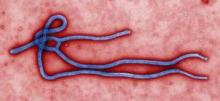CDC officials are “deeply concerned” that a health care worker in Dallas has tested positive for Ebola virus as a result of contact with Thomas Duncan, the index patient from Liberia who died Oct 8.
In an emergency press conference Oct. 12, Dr. Thomas Frieden, director of the Centers for Disease Control and Prevention, blamed what he called a breach of protocol for the infection.
However, Dr. Frieden said that investigators had yet to identify any specific breach of protocol at Texas Presbyterian Hospital, Dallas. He pointed to two procedures performed on Mr. Duncan – respiratory intubation and kidney dialysis – as having the potential to have spread infection to the health care worker.
Additional health care workers treating Mr. Duncan are being closely monitored along with all of Mr. Duncan’s contacts both before and after admission, Dr. Frieden said.
“Unfortunately, it is possible that we will see additional cases of Ebola,” he said.
The CDC is mulling a policy in which procedures performed on Ebola patients would be limited to those deemed “essential.” Pressed to explain, Dr. Frieden said that for example, blood draws to monitor electrolytes could be limited to one per day, down from three, to reduce potential for exposure.
Dr. Frieden also cited the need to reduce the number of health care workers caring for patients with Ebola.
The news of an infected health care worker at Texas Presbyterian Hospital, Dallas, which initially failed to isolate Mr. Duncan, drew questions as to whether suspected Ebola infection cases should be transferred to special treatment centers with isolation units instead of being treated for locally.
Dr. Frieden said that it was important that all hospitals be ready to diagnose and isolate Ebola patients safely. “We can’t have any hospital let its guard down,” he said, adding that the CDC has not ruled out transferring Ebola patients to specially equipped centers for treatment.
Confirmatory results for the health care worker were expected later Oct. 12, Dr. Frieden said. The health care worker had been self-monitoring for symptoms as instructed, when she presented with a low-grade fever, and viral levels that Dr. Frieden said appeared to be low. The health care worker only reported having a single contact following the first appearance of symptoms.
Dr. Frieden said that the agency was continuing to investigate the 48 contacts of Mr. Duncan before his isolation and admission to the hospital and that it had opened another investigation into his post-admission contacts.
“It’s deeply concerning that this occurred,” Dr. Frieden said, but he added that the case “doesn’t change the bottom line, which is that we know how to break the chain of transmission” though prompt diagnosis and isolation and notification of contacts.
This new infection signifies a further need to “ramp up infection control” in the hospital setting, he said. “We know how Ebola spreads, we know how to stop it, but this reemphasizes how meticulous we have to be.”

